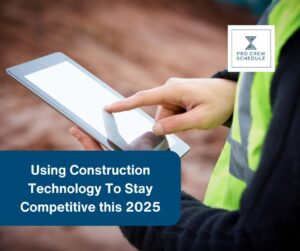Nowadays, construction professionals are trying to accelerate the adoption of technologies in their operational processes. When these technologies are utilized efficiently and effectively, this can completely change how you handle your projects – from streamlining your business processes and improving collaboration and productivity to driving up salaries and profit margins. Luckily, today’s real-time technologies offer many features that allow you to get game-changing benefits, helping you achieve optimum project performance.
With the world slowly leaning into modernization and digital tools, there is a lot of construction technology available in the market – from 5D BIM, data analytics, drones, and mobile solutions to collaborative platforms like big data. These technologies can aid your business in completing projects on time and within budget while keeping a high standard for quality. When it comes to project management for construction, most managers often go for collaborative technology such as real-time, cloud-based software to gather 1extensive data repositories to make sure all stakeholders – architects, consultants, engineers, subcontractors, specialty tradespeople, contractors, and the top management all have access to the same information.
In this article, let us discuss how contractors can leverage these technologies in order to guarantee optimum project performance.
Defining Construction Technology
In a nutshell, construction technology is a set of novel tools, machines, modifications, and software utilized throughout the construction phase to enable advancements in field construction methods, such as semi-automated and automated construction equipment.
Every construction site is unique, with its own set of dangers and problems. This makes streamlining operations and increasing efficiency challenging, especially in our industry. Luckily, there are software and mobile solutions available today to manage all aspects of a construction project. From preconstruction through post-construction, project management, and field reporting, these technologies can help you optimize your operational processes and increase efficiency and productivity. Most of these digital solutions are cloud-based, providing real-time updates to documents, and schedules, improving communication and cooperation.
Some common construction technologies leveraged by contractors today are:
- Data Collection Apps
- Drones and Sensor Devices
- Building Information Modeling Software
- Virtual Reality and Wearables
- 3D Printing
- Artificial Intelligence
- Machine Learning
Investing in cutting-edge construction technologies is unquestionably a wise business decision. Though most can be skeptical at first due to the risk of investment, this article aims to identify the technological tools that can assist you in achieving your firm’s goals.
Five Benefits to Utilizing Construction Technology in Your Project Management System
As stated earlier, utilizing construction technologies can help you steer away from the old, manual, and repetitive processes and pave the way to a more efficient, automated, and streamlined way of managing construction. Thus, these technologies can help you enhance your project’s quality, lower total costs, and ensure client satisfaction. This section has listed five benefits of boosting construction efficiency with technology.
Allows the Team to Communicate and Collaborate More Effectively
Contractors can connect and work with stakeholders more quickly when using technology, whether from the office or field. You can gather data on the job site and share it with everyone on a real-time basis. Online and mobile apps, such as construction scheduling software, offer comprehensive features that allow smooth communication and collaboration from within your organization. From reporting to document sharing, construction management, auto-archiving, and data collection, these are all useful tools to help you increase your project’s performance.
Offers Real-Time Data That Allows the Team to Make Informed Business Decisions
Team members can make real-time revisions to the data online to revaluate how the project progresses against the scope, cost, and schedule baselines. Whenever an unforeseen circumstance requires a fast decision, having access to real-time data allows everyone to make informed business decisions while also considering budget and timeline limitations. It also raises the likelihood of the project staying on budget and schedule.
Streamlines, Simplifies and Automates Construction Processes
Construction technologies eliminate the need for numerous paperwork – nearly everything can be uploaded and accessed online with a few simple clicks. Supervisors can record employee hours on a mobile device and wirelessly communicate the information to the field office, effectively raising the bar for an effective construction crew management system. This data is then effortlessly linked into the company’s core system, reducing the inaccuracies and inefficiencies of storing records on paper. As a result, companies can enhance accuracy and cut processing costs by using software to track every intricate detail of the project.
Ensures Accurate Documentation
Construction teams can better meet documentation and compliance rules by using technology on the job site to complete essential documents more precisely and promptly. Electronic document management solutions, for example, can store digital photos, videos, and documents. These systems can then be accessible via a secure online document portal from any mobile device. This saves a lot of time while also lowering the risk of penalties, which may be very costly.
Access Data with a Few Simple Clicks
Mobile technologies, such as tablets and smartphones, can help in improving job site workflow efficiency. Combined with cloud-based data storage and management systems, these technologies can significantly reduce lag times from passing the information back and forth. Contractors can access designs, paperwork, contracts, and other crucial information in real-time from the project site, reducing wait time and allowing them to prevent costly mistakes.
Seven Ways to Leverage Technologies to Optimize Construction Processes
New construction technology has always propelled the industry forward – nowadays, we can construct stronger, taller, and more energy-efficient structures. These technological advancements make construction sites safer, and workers are more productive. However, you must know how to leverage its features to reap its benefits, such as boosted productivity, improved teamwork, and the ability to take on more challenging tasks. This section has listed seven ways to make the most of the construction technologies available.
Gather Data and Prioritize Digital Technology
Construction and engineering firms can use big data to collect and analyze cost-related data, site-based transactions, photos, conversations, and planned modifications, among other things. A construction project has a million moving parts that generate hundreds of pieces of data, so it is a bit overwhelming to gather all the data. It is impossible to recognize essential data items without digital technology, enabling swift responses to future problems and applying positive outcomes to future projects.
Mitigate and Analyze Possible Risks
The collection and analysis of data – be it current or historical data, from building projects can aid in the identification of potential dangers and issues. This allows you to have a clear view of all the possible scenarios that can happen based on past projects and, in turn, prepare you and your team for any potential delays, weariness, and overall project time and expense overruns by assessing the productivity of vital resources such as labor and equipment.
Leverage Automations and Predictability Features
Before a project begins, comprehensive data systems are combined with disruptive technologies such as artificial intelligence (AI) and machine learning (ML) to provide essential information and insight. Potential challenges, including construction site coordination issues, disagreements between different disciplines and trades, and even weather influence, can be addressed before it’s too late. For example, subcontractor scheduling software can alert you when a task is completed and automatically moves to the following tasks that the team should be working on.
Utilize And Integrate Big Data with Building Information Modeling
As early as the design process, big data transforms the construction business. Data can be collected and used to assist in the design process. With the construction technology in place, large amounts of data can be quickly evaluated and used to identify probabilities and patterns that may be used to predict potential issues that may arise during the construction process. By feeding that information back into a BIM solution, you may get a more precise and accurate picture of the construction process.
Shift to Lean Construction Processes
The construction industry is notoriously well-known for generating a lot of production waste. Given today’s digital technology, there’s just no excuse for such waste, both materials, equipment, and time. Most companies are now turning to inventory management software due to a recent focus on lean construction concepts to reduce material waste. These technologies deliver real-time data to the entire project team, enabling more efficient material, plant, and equipment supply and use.
Improve Inventory and Resource Management
Construction apps can be used on modern construction sites to collect data from warehouses, plants, and machinery to have clear visibility of your materials, resources, and equipment. Sensor data can reveal the idle and active times of construction machinery, allowing contractors to improve fuel efficiency and productivity while determining whether it is more cost-effective to buy, lease, or rent such machinery.
Maintain An Excellent Work Environment
In addition to giving critical insights into the productivity and efficiency of plants and equipment, sensor-enabled wearable gadgets can significantly impact the working conditions of site staff. These sensors can monitor environmental variables that affect workplace safety, but they can also monitor workers’ health using biometric sensors built into the wearable.







